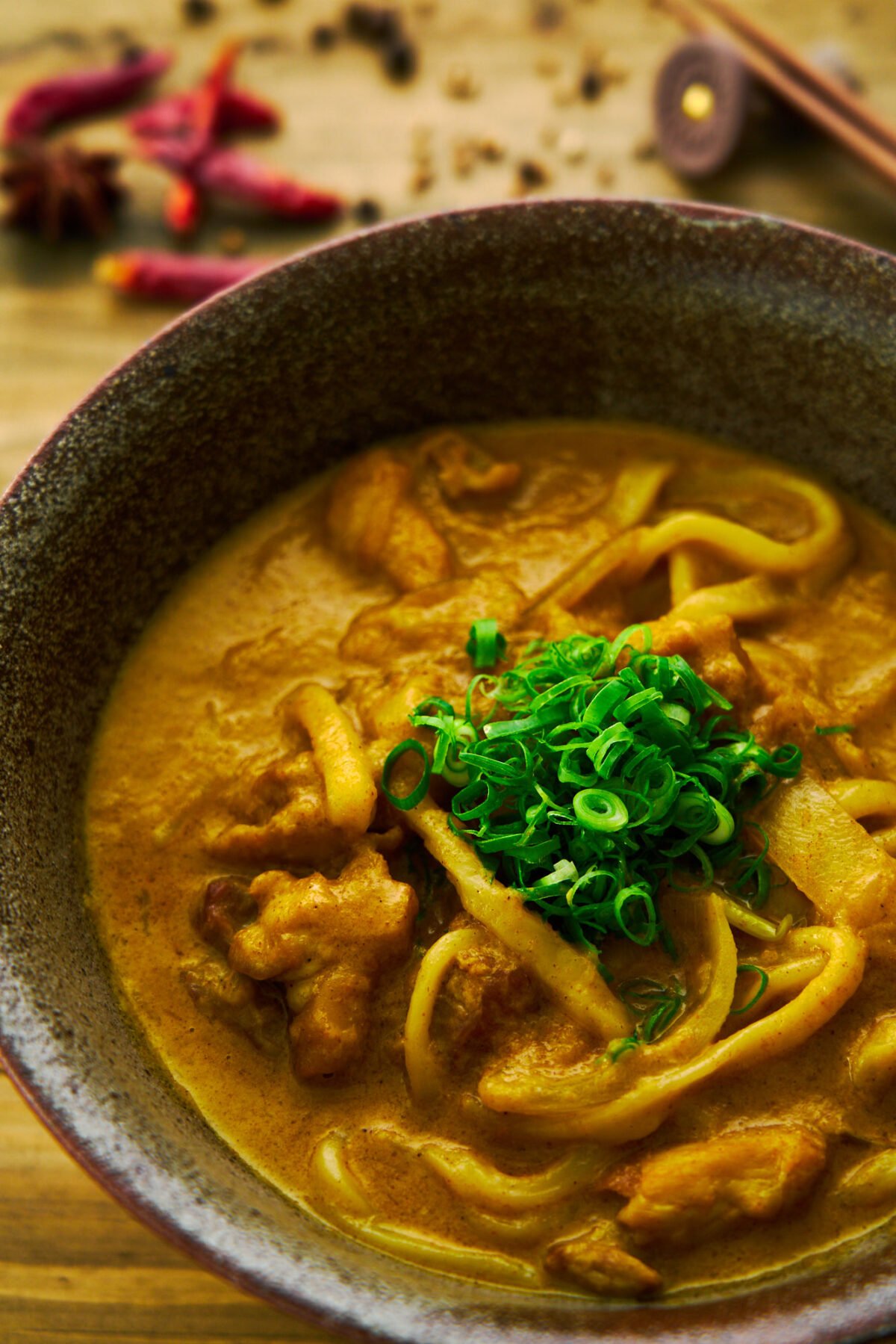
Curry Udon (カレーうどん)
Growing up, my mom would often make Curry Udon (カレーうどん) the day after preparing a big pot of Japanese Curry, by ladling a scoop of the thick, flavorful curry over a bowl of steaming hot udon noodle soup. The rich, slow-cooked curry melds into the clear dashi-based broth transforming the light soup and unleashing a torrent of umami.
The problem is that we don't always have leftover curry sitting in the fridge, and spending a few hours making a pot isn't a practical way of sating a curry udon craving. That's why I've come up with this relatively quick curry udon. It comes together in about 20 minutes, and I think it tastes better than the version made with leftovers.
There are so many different variations of Curry Udon in Japan, but my favorite version is from a chain called Konaya (古奈屋). Their soup has all of the umami of traditional udon broth, but with the sweetness of caramelized aromatics and the palate opening spices of a good curry. The thing that makes theirs unique is a subtle creaminess that mellows out the piquant spices. This was the taste I set out to recreate with this Curry Udon recipe.

Jump to:
Why This Recipe Works
- Using skin-on chicken thighs speeds up the cooking time because you don't need to wait for the meat to get tender. The skin also keeps the chicken from getting tough, while rendering out enough fat to caramelize the vegetables.
- Caramelizing the vegetables is what gives Japanese curry its sweet and umami-rich taste. Usually, this is a process that takes over an hour to accomplish, but by grating the vegetables and raising their pH with baking soda, it's possible to speed this up to around 3 minutes.
- Sour cream added at the end adds body to the soup while making the curry taste like it has been simmering for hours.
Ingredients for Curry Udon
- Chicken - I like to use chicken thighs for this dish because it cooks quickly, stays tender, and releases a lot of umami into the broth. Skin-on chicken allows you to get some nice browning on the skin side without drying the meat out and making it tough. The oil that renders out from the skin also helps in caramelizing the vegetable paste. If you go with skinless chicken, be sure to increase the amount of vegetable oil. You can also make Curry Udon with beef or pork, but it's important to slice it very thinly; otherwise, it's going to end up tough due to the short cooking time. Another option here is to use ground meat.
- Vegetable paste - The foundation of all good Japanese curry starts by sauteing garlic, ginger, and onions until they're caramelized. This is a time-consuming process, even with my baking soda hack. To speed this up even further, I've grated the aromatics along with some carrots. Together with a little baking soda to raise the pH, this slurry brings the caramelization time down to a few minutes, and the resulting vegetable paste forms the base for the curry.
- Curry Powder - Japanese curry powder has a unique blend of spices, including star anise and Japanese citrus, that are not added to other types of curry powder. This recipe will still work with curry powder from other countries, but if you want to make it taste like Japanese curry, finding a Japanese curry powder is key. I also have a recipe for blending your own curry powder.
- Dashi - Dashi is the Japanese word for soup stock, and it most commonly refers to a traditional Japanese soup stock made from konbu and katsuobushi. Dashi is the base for most traditional Japanese soups, including miso soup, udon, and soba. You can read more about it in my post on how to make dashi. If you can't find it, you can substitute another kind of soup stock such as vegetable or chicken stock, but keep in mind that it's not going to taste quite the same.
- Mirin - Mirin is a sweet alcoholic beverage made by fermenting wholegrain rice with kōji. The sweetness is created due to kōji breaking down the starches in the rice into simple sugars. Mirin is usually added to noodle soups to add umami, as well as a balancing sweetness. Since Japanese curry tends to be quite sweet, I've added a little more mirin than you would typically add to a noodle soup. This provides sweetness without having to add any extra ingredients. The alcohol in the mirin (as well as the soy sauce) is burned off as the soup is cooked, so you don't have to worry about getting drunk off the soup. When you're buying mirin, be sure to read the ingredient label, as there is a lot of fake mirin out there. It should contain rice, kōji, and alcohol; it should not contain corn syrup, MSG, or salt. If you can't find good mirin, you can substitute 2 tablespoons of sake plus 4 teaspoons of sugar.
- Soy Sauce - Japanese soy sauce is the seasoning of choice for traditional udon noodle soup. I don't like using too much soy sauce in my soup broths because it can become overwhelming. That's why I use a mixture of soy sauce and salt to season all of my soups. For this Curry Udon, there's just enough soy sauce to add umami and a subtle nutty flavor, but not enough to have a noticeable soy sauce taste.
- Chuno Sauce - Chuno sauce is not generally added to noodle soups, but it is added to Japanese curry, which is why I've added it to my Curry Udon. It's a sweet and spicy fruit sauce that tastes a little like sweet Worcestershire sauce. Chuno sauce is in the same category of sauces as tonkatsu sauce and okonomiyaki sauce, making these suitable substitutes. If you can't find any of those, you can make an approximation by mixing ketchup and Worcestershire sauce in a 50:50 ratio.
- Udon Noodles - Udon Noodles are a wheat-flour-based noodle that comes in various thicknesses. For Curry Udon, I recommend using one that's on the thicker side (⅛-1/4-inch in diameter). It typically comes either dried, fresh uncooked, fresh pre-cooked, or frozen pre-cooked. In the case of pre-cooked udon (both fresh and frozen), you can just drop the blocks straight into the soup after the chicken is cooked. For everything else, check the packaging for cooking times, as it will vary depending on the type of udon and thickness. Since you want to finish cooking the udon in the curry, be sure to reduce the cooking time by 3 minutes. If you want to try your hand at making your own udon, it's made with just water, flour, and salt, so check out my homemade udon recipe.
- Sour Cream - The curry udon at Konaya gets its subtle creaminess from milk, but I prefer adding a little sour cream instead. Since it's tempered and added at the very end, you can avoid any issues with curdling, and its concentrated nature prevents the dilution you'd get from adding milk at the end. It also adds a barely perceptible tartness that adds more depth to the soup. When adding the sour cream to the curry, it's important to temper it first by whisking in a little hot soup at a time to raise its temperature slowly.

How to Make Curry Udon
The first thing you need to consider is how long your udon is going to take to cook. If it's pre-cooked, you can add it straight to the soup, so you don't need to worry about boiling it first, but if you're using dry or fresh uncooked noodles, you'll want to subtract 3 minutes from the cooking time specified on the package and boil it accordingly.
Next, you want to cut the chicken into bite-size pieces and season it with salt. Heat a wide pot or chef's pan over medium-high heat until it's hot and add the oil, and then the chicken, skin-side down. Let it fry until the skin is golden brown (2-3 minutes).
Grate the onion, carrot, garlic, and ginger, and then stir in the baking soda. This lowers the pH of the vegetables, making it easier to brown them.
When the chicken has browned, transfer the pieces into a bowl, and leave as much oil in the pan as possible. It's okay if the chicken isn't fully cooked at this point, as you're going to cook it some more in the curry.
Add the grated vegetables to the pan you fried the chicken in. It will spatter, so be careful. Sauté this mixture until it has formed a golden-brown paste. It will take about a minute for the liquid to evaporate and then another two to three minutes for the paste to caramelize.
When the vegetable paste is golden brown, add the curry powder and toast it together with the paste for about thirty seconds. Add the dashi, mirin, soy sauce, chuno sauce, ¼ teaspoon of salt, and sliced onions, and then return the chicken to the pan. Simmer the curry until the chicken and onions are cooked through.
When the udon is done (3 minutes less than the package directions), drain and rinse the noodles in cold water and then add them to the curry soup. Cook these together until the udon is done to your liking.
Finish the curry by tempering the sour cream with the hot curry. You want to whisk a ladleful of the hot curry into the sour cream at a time until the mixture is lukewarm. Then you can turn the heat off and stir the sour cream mixture into the curry. Make sure you do this with the heat turned off; otherwise, it may curdle.
Serve the Curry Udon garnished with chopped scallions.
Other Udon Recipes
FAQ
Curry Udon is a Japanese noodle soup. It was conceived as a mashup of traditional udon noodle soup with Japanese-style curry, but it's since become one of the most popular udon dishes.
In the early 20th century, Tokyo saw an influx of "western-style" restaurants enter the market, featuring dishes like curry rice and hamburg steak. Seeing a loss of business due to the new competition, Sanchōan (三朝庵), a storied soba shop near Waseda University, created a mashup using their dashi stock with the flavors of curry rice.
Curry udon is pronounced karé udon in Japanese:
ka like copy
ré the extended “re” sound does not exist in the English language and the best way to make it is to say the word "ray" with the tip of your tongue at the front of your mouth.
u like oops
don like donut
If you happen to have some leftover Japanese curry, it's very easy to turn it into Curry Udon. Just use the dashi, mirin, soy sauce, and salt from the Curry Udon Soup recipe below, and then add your leftover curry to taste. Then you can boil and add the noodles and garnish with some scallions.
It is possible, but this recipe relies on chicken, dashi, and sour cream, so it won't be an easy 1 for 1 swap. If you want to see a vegan version of this recipe, please leave me a comment below. If I get enough interest, I'll do a recipe for it.
📖 Recipe


Units
Ingredients
Chicken
- 250 grams boneless skin-on chicken thighs
- ¼ teaspoon salt
- 1 tablespoon vegetable oil
Curry Paste
- 100 grams onion (½ medium onion, grated)
- 60 grams carrot (½ carrot, grated)
- 10 grams garlic (2 medium cloves, grated)
- 10 grams ginger (grated)
- ⅛ teaspoon baking soda
- 2 tablespoons Japanese curry powder (such as S&B brand)
Curry Udon Soup
- 2 ½ cups dashi stock
- 2 tablespoons mirin
- 1 tablespoon soy sauce
- 2 teaspoons chunou sauce
- ¼ teaspoon salt
- 100 grams onion (½ medium onion, sliced)
- 240 grams fresh udon (450 grams pre-cooked udon or 150 grams dried udon)
To Finish
- ¼ cup sour cream
- Scallions (chopped for garnish)
Instructions
- Cut the chicken into bite-sized pieces and season on all sides with ¼ teaspoon of salt.

- Set a large pot of water on the stove over high heat to boil the udon. If you are using pre-cooked frozen udon, you can skip this step.
- Heat a frying pan over medium-high heat until hot. Add the oil and then the chicken, skin-side down. Let the chicken fry undisturbed until the skin-side is browned (about 2-3 minutes).

- While the chicken is browning, grate the onion, carrot, garlic, and ginger. Then mix in the baking soda.

- When the chicken has browned on the skin-side (it's okay if the chicken isn't fully cooked), transfer it to a bowl while leaving as much of the oil behind in the pan as possible. Set the chicken aside.

- Add the grated vegetables to the pan you fried the chicken in. It will spatter, so be careful. Sauté this mixture until it has formed a paste and is caramelized (about 3 minutes).

- Boil the udon for 3 minutes less than what the package directions say. Udon tends to boil over, so be sure to keep an eye on it.

- Add the curry powder to the pan with the caramelized veggie paste and continue sautéing until the mixture is uniform in color and very fragrant.

- Add the dashi, mirin, soy sauce, chuno sauce, and remaining ¼ teaspoon of salt to the pan with the curry paste. Return the chicken to the pan, and add the onions. Let this simmer for about 5 minutes, or until your udon is cooked.

- When the udon is done (3 minutes less than what the package directions say), drain the noodles and wash any extra starch off the noodles with cold water. Add the udon to the curry and simmer until the chicken and udon are cooked through.

- To finish the curry udon, turn down the heat to low. Ladle some of the hot soup into a bowl with the sour cream and whisk this together. Keep adding soup and whisking until the sour cream is warm. Pour this into the pan with the curry udon and stir-to incorporate.

- Serve the curry udon immediately, garnished with scallions.

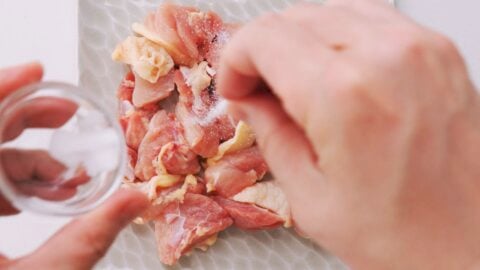


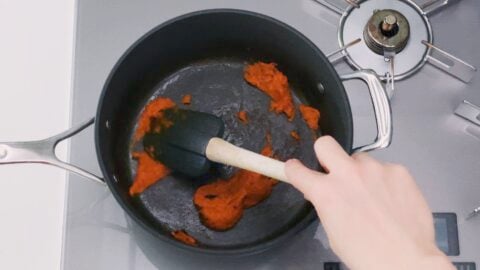
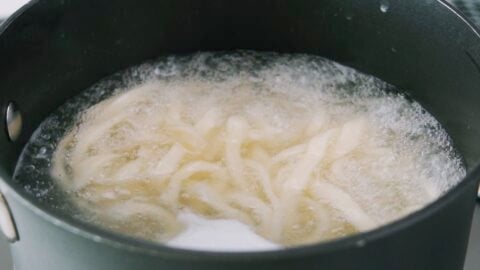
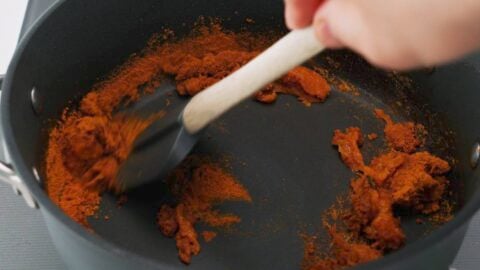
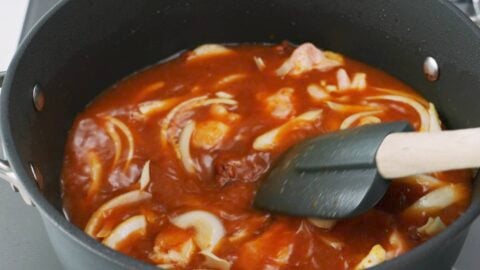
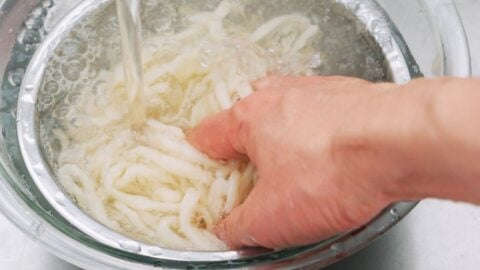
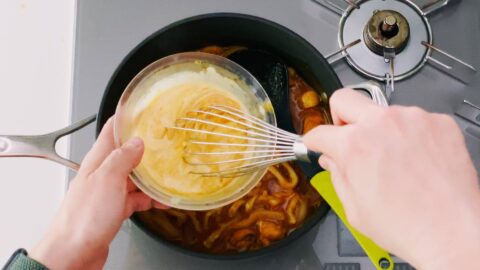
SNL says
I'm from the UK and I'm not certain we get "the right mirin". Authentic flavour. An own brand (shop/store version) is 64% rice wine, glucose syrup and water. Whereas "Yutaka brand" known for a range of Asian products, their mirin is glucose syrup, water and 2% fermented rice alcohol which doesn't seem right at all, hence the confusion. Can't get Sake here (or rather I don't want to use Amazon to buy food). Would Chinese wine - shaoxing wine and sugar work as a substitute for a more authentic flavour? That looks more authentic with just 3 ingredients (water, glutinous rice and wheat). Thank you for any help you can give 🙂
Marc Matsumoto says
Hi SNL, yep, neither of those are real brewed mirin (glucose syrup is just another way of saying "sugar water"). Using Shaoxing + sugar will make a fine substitute for mirin (it's pretty close in flavor).
Anna says
Hi Marc,
I would like to read a vegetarian version. I always got dashi from kelp and katsuobushi, but I don't eat a lot of meat and almost never got one at home. So I would like to know a tasty version which I could make really fast without meat.
What is Chuno Sauce? I never read that in a japanese recipe before, but would love to learn.
Thank you
Anna says
Oh and I would like the recipe without all the mushrooms which you suggest in the first comment. I never got mushrooms at home, so I would end up never doing the recipe. Perhaps I could go with Chicken Broth Powder? (I'm from germany, that's all available here) But I think it could taste delicious without mushrooms because the dashi got umami and all the spices .... mmmyamm myamm got hungry here
Marc Matsumoto says
Hi Anna, I've recorded your request for a vegetarian version of this dish. As for Chunou sauce, please read the headnotes which contains an explanation of all of the ingredients in this dish.
Naomi Woolf says
thank you so much for bringing new ideas for the curry. Can I cook mutton in the same way instead of chicken?
Marc Matsumoto says
Hi Naomi, you're welcome! Mutton is more tough than chicken so it would only work in this recipe if it were sliced very thinly (1mm in thickness). The other option is to cook it for much longer in the soup, but you will probably need to cook the soup for over an hour, which would also mean you'd need to add more liquid to make up for the evaporation that will occur during that time.
Lilly Brooklyn says
I have never tried such curry but now after reading about it, I am gonna to make this at my home. i am sure it will as deliciuse as I am assuming. Thanks for sharing such amazing recepie.
Marc Matsumoto says
You're welcome, I hope you enjoy it!
Tara says
This looks amazing! Do you have any tips to getting the pre-packaged udon taste out of the udon? The ones we have where I'm from have a strong taste and smell, almost like play-doh!
Marc Matsumoto says
Thanks Tara! Where are you located and what brand of udon are you talking about (a link to a product page would be helpful). Udon noodles definitely have a wheat-like smell, but this is largely based on the flour you use for the noodles. In Japan we have a type of flour that is specifically raised for making udon. It has a gluten content similar to all-purpose which gives it it's chewy texture, but it's going to have the best aroma and color for the noodles.
Tara says
Hi Marc, thanks so much for your reply! I'm based in Singapore, and I bought this particular udon - Miyakoichi Sannin Mae Udon. https://www.google.com/search?q=MIYAKOICHI+Sannin+Make+Udon+3sX200g&rlz=1C1GCEA_enSG865SG865&sxsrf=AOaemvLJ6_4BEAZ9TZDwu63k4heMqgv3qQ:1634043196514&source=lnms&tbm=isch&sa=X&ved=2ahUKEwiO5Zmi9cTzAhWOUn0KHUZSBqwQ_AUoAXoECAEQAw&biw=1912&bih=929&dpr=1#imgrc=EvvQ-iVmpVhDPM
Marc Matsumoto says
Hi Tara, thanks for the details. I'm not familiar with this brand, but it looks like it's a pre-boiled shelf stable udon. This is a little unusual because preboiled noodles are usually sold either refrigerated or frozen here in Japan. I'm not sure if the way they process these noodles to make them shelf stable has anything to do with the taste, but that's one possibility or it could just be the type of flour they use. Here is the brand of flour I use for my udon noodles. https://www.amazon.co.jp/-/en/dp/B07Q6ZZVXB/ref=sr_1_11?dchild=1&keywords=うどん小麦粉&qid=1634044672&sr=8-11
Annie says
This sounds delicious, but I'm lactose intolerant. Is there any dairy-free substitution for the sour cream, or would it break the recipe to leave it out?
Marc Matsumoto says
Hi Annie, funny that you should mention that, I was just reading a report on 23andMe that 99.9% of East Asians on their platform are lactose intolerant. You could leave the sour cream out, but it will lack the richness and body of adding it. I think coconut cream would be a good alternative that will go with the flavor of the curry.
Felicity Buchanan says
Haven't tried to make this yet, but could you successfully substitute chicken breasts? I know they are drier, but I just don't like thighs.
Marc Matsumoto says
Hi Felicity, you could but as you mentioned it will be drier and have less flavor. If you do chose to use chicken breast, I would recommend reducing the amount of time you cook the chicken in the soup. i.e. add the onions in and let them cook through and then return the chicken to the pot when you add the udon noodles to finish cooking them. This should minimize the dryness.
Merrina says
YES! I would be overjoyed to see a vegan curry udon recipe!
Marc Matsumoto says
Thanks Merrina, I haven't decided whether to do one yet or not, but at a concept level here's what I'm thinking:
1) For the dashi, replace it with shiitake and konbu dashi
2) For the chicken, replace it with a variety of mushrooms (shiitake, eryngi, Maitake)
3) For the sour cream, replace it with cashew cream (raw cashews pureed with water and a bit of lemon juice)